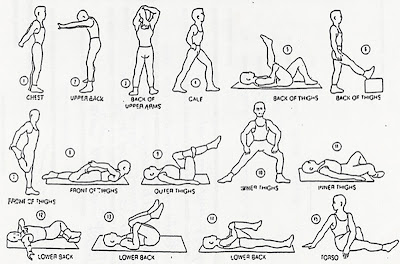What is Flexibility?
Flexibility is the amount of movement available at a joint. For example, the amount of movement available at the hip joint is determined by how far the leg can be moved in each of the permitted motions (e.g. flexion - raising the leg up in front). The term flexibility means the same as mobility or suppleness.
Flexibility is determined by a number of factors:
- Type of joint:The shoulder - a ball and socket joint, is more flexible (or mobile) than the knee - a hinged joint, for example.
- Muscle tissue elasticity: Injured, poorly conditioned, tight muscles are less flexible.
- Elasticity of tendons: Tendons should stretch slightly although not to the extent of muscles.
- Laxity of ligaments: Following injury, ligaments can become lax resulting in excess joint movement. Some people are also born with lax ligaments.
- The ability of a muscle to relax: Some muscles are unable to fully relax due to increased tone - usually postural.
- Temperature of the joint and associated tissues: Joints and muscles offer better flexibility at body temperatures that are 1 to 2 degrees higher than normal.
- Bony structures which limit movement: Some people develop bony growths known as spurs which may limit joint motion.
- Temperature of the environment: Warmth promotes flexibility.
- Time of day : Flexibility is lower first thing in the morning.
- Injuries: Muscles often tighten up to protect an injury, resulting in lower flexibility.
- Age: Flexibility tends to decrease with age.
- Gender: Females are on average more flexible than males.
-
Why is it important to be Flexible
Being flexible helps to reduce the risk of injuries by maintaining the body in a state of balance.
Our muscles work in pairs to cause movement on a joint. One muscle shortens to move the joint as the other relaxes to stretch and allow the full movement. If one of these muscles is tight, this affects the balance at the joint as the muscle which is contracting cannot do so through its full range and so becomes weaker. Muscle imbalances such as this result in alterations in posture and compensation through altered biomechanics.
A common example of reduced flexibility causing injury is the shoulder joint. If the chest muscles are shortened through frequent slouching at a desk, this pulls the shoulder joint forwards. If the shoulder retractors (i.e. lower traps and serratus anterior) are not strong enough to counteract this force, the joint moves forwards, affecting the mechanics of the shoulder and reducing the space in the joint , often resulting in an impingement syndrome.
Similarly, tight calf muscles can be a problem in runners. If the calf muscles are tight the amount of dorsiflexion at the ankle is reduced. To compensate for this, the foot pronates further which causes excess rotation of the lower leg and can contribute to conditions such as Shin splints and Achilles tendonitis
Being flexible will also help us to perform at our best in our chosen sport. Whilst some sports obviously benefit from flexibility (such as gymnastics, hurdling and high jump), others may not be as clear. However flexibility allows us to perform certain skills such as agility and balance more efficiently, aiding performance and decreasing the risk of injury..
More flexibility tips:
There are other ways in which flexibility can be improved. These include:
- Sports massage: Sports massage works to increase muscle flexibility by stretching the fibres, breaking down adhesions, trigger points and scar tissue and warming the muscles prior to stretching.
- Perform thorough warm-up's: Warming-up before exercise will gradually increase the temperature of your muscles and along with this your flexibility, helping to avoid injuries.
- Stretch after exercise: Stretching after exercise will help to prevent muscle stiffness caused by muscle damage sustained during exercise.
- Stretch first thing in the morning: This helps to set the muscle length for the day.
- Strengthen the opposite muscle: For example, if you have tight hamstrings, you should also look to increase the strength of the hip flexor muscles such as Rectus Femoris and Iliopsoas. The reason for this is that these muscles work to hold the hamstrings in their lengthened position (hip flexion).
- Warm the muscle: Using a warm pack or warm bath prior to stretching will help you get better results.
- Drink lots of water: Keeping hydrated helps to flush out toxins from the muscles.



Geen opmerkingen:
Een reactie posten